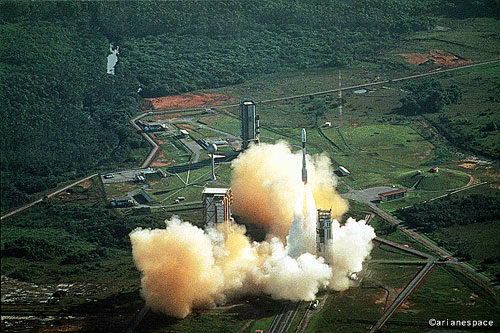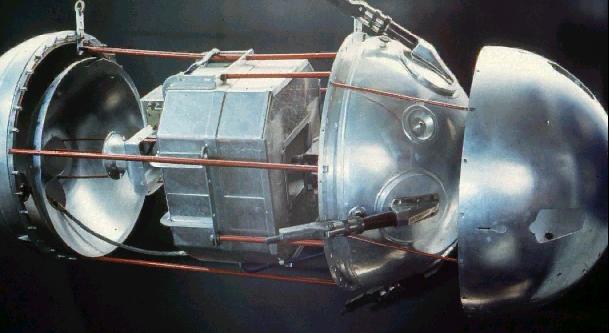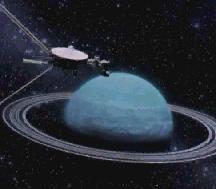Le coin des amatheurs de sciences version 2 
The sections of the site : The site  FORUM
FORUM  The space
The space  The genetics
The genetics  Medicine
Medicine  Physics
Physics  Tintin and science
Tintin and science  Ecology - Nuclear energy
Ecology - Nuclear energy  Mysteries of the history
Mysteries of the history  Humour
Humour  Diverse
Diverse
Le coin des amatheurs de sciences version 2 
The sections of the site : The site  FORUM
FORUM  The space
The space  The genetics
The genetics  Medicine
Medicine  Physics
Physics  Tintin and science
Tintin and science  Ecology - Nuclear energy
Ecology - Nuclear energy  Mysteries of the history
Mysteries of the history  Humour
Humour  Diverse
Diverse
Total history
October 4, 1957 : Placing in orbit of the first artificial satellite, Spoutnik 1. It weighed 83 kg for a diameter of 58 cm. Disintegrated on January 4, 1958.
November 3, 1957 : The bitch Laïka is the first alive being in orbit on board Spoutnik 2. It survives one week, the satellite fall on April 14, 1958.
January 31, 1958 : Explorer 1 is the first American artificial satellite
March 17, 1958 : Second American satellite : Vanguard 1, first satellite equipped with solar panels.
October 1958 : Foundation of NASA (National Aeronautics and Space Administration)
December 18, 1958 : First radio transmission since space.
Beginning of the Sixties : Foundation of the ELDO and the ESRO to build launchers respectively and of the European satellites.
April 12, 1961 : Youri Alexeievitch Gagarine is the first man in space with capsule Vostok 1. The journey lasts 108 minutes.
May 5, 1961 : Alan Shepard is the second man in space on board Mercury (or Freedom 7)
May 16, 1963 : First satellite released by a vessel
June 16, 1963 : Valentina Terechkova is the first woman in space
March 16, 1965 : Alexei Leonov carries out with the vessel Voskhod 2 the first exit in space. It lasts 10 minutes.
December 15, 1965 : The first docking in space is realized by Gemini 6 and Gemini 7
May 1968 : Construction of the base of Kourou.
December 24, 1968 : Frank Borman, William A. Anders and James A. Lovell carry out the first overflight of the Moon.
July 21, 1969 : Neil Armstrong and Edwin Aldrin are the first men on the Moon with Apollo 11. Their exploration lasts two hours and half ; Michael Collins remains in orbit. (for more precise details, see the page about Apollo program)
April 1970 : Catastrophe of Apollo 13
May 1971 : Launching of the first probes for the study of Mars : March 2 and 3 for the USSR ; Mariner 9 for the United States.
1975 : Fusion of the ELDO and the ESRO to form the ESA (European Space Agency
December 24, 1979 : Ariane 1st
April 12, 1981 : First shuttle
February 1st, 2003 : Columbia's accident
History of the launchers (photograph : Ariane 4)
 There are two kinds of launchers : traditional or fused launchers, which are single once usable, and shuttles usable several times.
There are two kinds of launchers : traditional or fused launchers, which are single once usable, and shuttles usable several times.
The principle of the propulsion with reaction (based on the law of the reciprocal forces of Newton) completion date of the XIXème century. It is due to a Russian teacher, Konstantine Tsiokovski. This one publishes an article in 1903 when it already thinks of fuels that it is necessary to use (alcohol, methane, kerosene for the small machines, liquid hydrogen for the large machines). Its work will be used in the Twenties, in particular in the United States, to create the first ballistic missiles. Largest progress is unfortunately made by the Nazi Germany with the missiles V2, of which the goal is the bombardment of London.
It is during the Sixties that one diverts the principle of the missiles to produce spacecraft : the Russians derive the missile R7 to create the launchers Vostok, Molnia and Soyouz ; the Americans create Juno 1 starting from the missile Jupiter C. France is the third country to have launchers : it acts since 1965 of the Diamant launcher, him also derived from missiles. With the end of the Seventies appear in Europe the Ariane launchers (more informations here).
All these launchers are rockets. From the side of shuttles, a lot of projects have existed, and even all of them have failed, for example Hermes in Europe (it was supposed to fly with Ariane). In fact, only two projects in the world have been concretized : the well-known american shuttle and Buran. This russian shuttle isn't as known as the american one because it flew only one time (November 15, 1988), without any crew. But we can admire it : Buran is the only engine that automatically took off, turned over Earth and landed.
The United States built 7 shuttles. In fact two of them, Pathfinder and Enterprise, were only built to do tests and they haven't been placed in orbit. The five other shuttles are Columbia, Challenger, Discovery, Atlantis and Endeavour. The first flight happened on April 12, 1981 (Columbia). On January 28, 1986, after having flown 73 seconds for its tenth mission, Challenger exploded. The seven members of the crew, including a teacher who had been selected to be the first non-specialist person in space, were killed. February 1, 2003 took place Columbia's accident. Whereas it lands, it explodes and kills the whole of the crew. The investigation reveals that a piece of insulating foam of the tank was detached and damaged the left wing. All the shuttle flights were then cancelled, until July 26th (you can see the details : The eventful mission of Discovery). So the only shuttles than can fly now are Discovery, Atlantis and Endeavour.
History of the satellites (photograph : Spoutnik 1)
 The first satellite is Spoutnik (Russian companion), launched in 1957 by the USSR thanks to the Zemiorka launcher. It contains a radio operator transmitter and four antenna-relays. One year later, the United States launches Explorer 1 starting from Cape Canaveral. It transmits during 112 days of measurements on the cosmic rays and the micrometeorites before falling down. One distinguishes five types of satellites :
The first satellite is Spoutnik (Russian companion), launched in 1957 by the USSR thanks to the Zemiorka launcher. It contains a radio operator transmitter and four antenna-relays. One year later, the United States launches Explorer 1 starting from Cape Canaveral. It transmits during 112 days of measurements on the cosmic rays and the micrometeorites before falling down. One distinguishes five types of satellites :
- satellites of astronomical observation as the Hubble telescope.
- satellites of navigation, in particular at the base of system GPS
- meteorological satellites. Some are in geostationary orbit (36000 km (22500 miles) of altitude ; they turn at the same speed that the Earth and thus remain always with the vertical of the same point) like Météosat, others are in low orbit (with the top of the equator, with less than 2000 km (1250 miles). It turn more quickly than the Earth and thus spend several times by day to the top of the same point).
- telecommunications satellites, most to support the rise of Internet and the mobile telephones.
- the military satellites (of communication or monitoring) of which the number is obviously secret.
History of the probes (artist's view : Voyager 2 near to Uranus)
 The probes are objects of observation which never return on Earth but transmit their information by radio. They are initially carried by a launcher, to escape from the terrestrial attraction, then become autonomous, according to a beforehand calculated trajectory.
The probes are objects of observation which never return on Earth but transmit their information by radio. They are initially carried by a launcher, to escape from the terrestrial attraction, then become autonomous, according to a beforehand calculated trajectory.
A lot of probes are intended for the study of Mars, because it is the only planet of our solar system which could possibly shelter forms of life. The first probe is Mars 1, launched by the USSR on March 19, 1962. The mission fails but the race is launched. In 1965, the American probe Mariner 4 transmits the first stereotypes of Mars. March 3 is launched on May 28, 1971. December 2, it releases a module which emits during 20 seconds. July 12, 1988, Soviet Phobos 2 carries out thanks to a French apparatus 40 000 photographs with infra-red. These photographs show the presence over Mars of old rivers. The Pathfinder probe launched on December 4, 1996 is posed over Mars on July 4, 1997. It takes measurements on the ground and the atmosphere and launches a robot (Sojourner) which explores surface on a ray of a few tens of kilometers. 2003 was the year of Mars and five probes were launched. For example, Mars Express (european probe) has studied the Martian atmosphere and have send many views. But the robot Beagle 2, which had been dropped by Mars Express, has been lost. A study concluded that the Beagle's constructors (english academics) were too in a hurry and that this mission should have been made by specialists.
The probe Voyager 1 visit in 1977 Jupiter and Saturne. The same year, Voyager 2 visit Uranus and Neptune. In November 2003, Voyager 1 is at 90 UA (13.5 billion kilometers, or 8.4 billion miles) from the Sun. Soviet side, Vega 1 and Vega 2 respectively explore Venus in 1985 and Halley's Comet in 1986. In 1994, Ulysse studies the poles of the Sun and since 1995, Soho studies the faces of the Sun.
Some probes do not have a precise goal, if is not to seek an extraterrestrial life. Several capsules as Pioneer 10 (March 3, 1972) wander in space, container of the representations of naked human couples (dimensions being indicated compared to the capsule) with the position of the Earth. Others like Voyager 1 and 2 carry vocal and musical recordings.
History of the space stations (photograph : Mir)
 Between 1971 and 1982, the Soviets install 7 stations of the Salyout type, lasting having been Salyout 6 (5 years of operation). May 14, 1973, the United States launches Skylab (24,6m/6,6m) or will remain three crews (28 days, 59 days and 84 days). The station is disintegrated on July 11, 1979 with the top of the Indian Ocean.
Between 1971 and 1982, the Soviets install 7 stations of the Salyout type, lasting having been Salyout 6 (5 years of operation). May 14, 1973, the United States launches Skylab (24,6m/6,6m) or will remain three crews (28 days, 59 days and 84 days). The station is disintegrated on July 11, 1979 with the top of the Indian Ocean.
In 1986, Soviet gives up the Salyout program with the profit of famous Mir whose first element will be placed in February 1986. The Salyout stations are left with the abandonment, the last disintegrating on February 7, 1991 while entering the atmosphere. Completed once, Mir could shelter a crew during one year.
Become too decayed, Mir is destroyed on March 23, 2001. Russia doesn't replace it, preferring to take part in the project of international station (baptized at beginning Alpha, yet named ISS) with 15 othe countries. Studied since 1984, the station is build since November 1998. During a time, Columbia's accident slowed the work because we just used Soyouz (that are smaller), which reduced supplies and crews (list here).
When it's finished (2010), the ISS will look like this :
